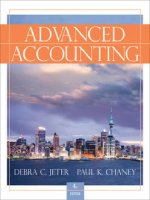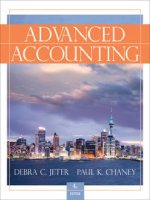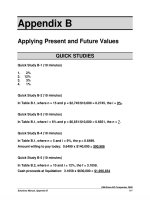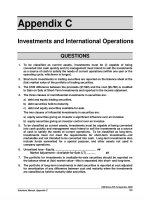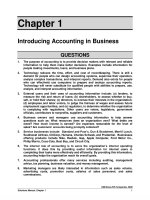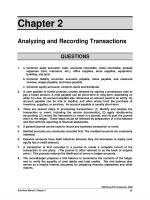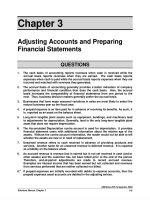Solution manual financial accounting 4e by wild chapter13
Bạn đang xem bản rút gọn của tài liệu. Xem và tải ngay bản đầy đủ của tài liệu tại đây (886.66 KB, 45 trang )
To download more slides, ebook, solutions and test bank, visit
Chapter 13
Analyzing and Interpreting
Financial Statements
QUESTIONS
1.
With comparative statements, financial statement items for two or more successive
accounting periods are placed side by side on a single statement, with the change in
each item expressed as both a dollar amount and a percent. Common-size
comparative statements express each financial statement item as a percent of some
base amount that is assigned a value of 100%.
2.
Total assets (or equivalently, the total of liabilities plus equity) are assigned a value
of 100% on a common-size balance sheet. Net sales (revenues) are assigned a value
of 100% on a common-size income statement.
3.
Financial reporting includes the entire process of preparing and issuing financial
information about a company. Financial statements are an important part of
financial reporting but they are less than the whole.
4.
The nature of a company's business, the composition of its current assets, and the
turnover of its current assets are three important factors that should be considered
in deciding whether a current ratio is good or bad.
5.
A 2-to-1 current ratio may not be adequate if the company's current assets consist of
a large proportion of slow-turning accounts, notes, and merchandise inventory. The
general nature of the business also may make the 2-to-1 rule of thumb inadequate.
6.
Adequate working capital enables a company to carry sufficient inventories, meet
current debts, take advantage of cash discounts, and extend favorable terms to
customers. Working capital is a major factor in determining the short-term liquidity
position of a company.
7.
When evaluated in light of a company's credit terms, the number of days' sales
uncollected indicates how quickly accounts receivable are converted into cash. This
provides information about the relevance of accounts receivable balances in
meeting the current obligations of the business.
8.
A high accounts receivable turnover implies that accounts are collected quickly,
thereby providing cash that can be used to meet obligations. A high turnover also
means that a given sales volume can be supported with a lower investment in
accounts receivable.
©McGraw-Hill Companies, 2008
Solutions Manual, Chapter 13
671
To download more slides, ebook, solutions and test bank, visit
9. Users are interested in the capital structure of a company, as measured by debt and
equity ratios, for at least two reasons. First, as a company includes more debt in its
capital structure, the risk that it will be unable to meet interest and principal
payments increases. Second, the existence of debt introduces financial leverage. If
the company can earn a rate of return on its investments that exceeds the rate of
interest paid to creditors, the debt will increase the rate of return to stockholders.
10. Inventory turnover reflects on the efficiency of inventory management. That is, a
high inventory turnover means that a given sales volume can be supported with a
smaller investment in inventory. This insight into the speed with which inventory is
sold determines the relevance of the available inventory in meeting the current
obligations of the business, which is a focus of short-term liquidity.
11. Since management is responsible for a company's performance, all ratios that are
useful in evaluating a company are of some usefulness in assessing management
performance. Profit margin, total asset turnover, return on total assets, and return
on stockholders' equity are especially useful for assessing management's
responsibility for operating efficiently and profitably.
12. The ratio of pledged assets to secured liabilities must be interpreted with care
because the book value of the pledged assets is used in calculating the ratio, and
the book value is unlikely to always approximate the assets‘ market value.
13. Almost all companies have some liabilities. Since total assets equals total liabilities
plus equity, total assets is almost always higher than common stockholders' equity.
Thus, the denominator in return on total assets is larger than common stockholders'
equity. Since the numerator is the same for both, and return on total assets has a
larger denominator, it yields a smaller percent. [Instructor note: A more complete
measure of return on assets would add back (Interest Expense x {1 – Tax Rate}) to
net income in the numerator—reflecting the after-tax cost of debt. We leave the
rationale for this adjustment to advanced courses.]
14. This gain is considered to be unusual but not infrequent. It would be included in the
calculation of income from continuing operations, with other unusual or infrequent
gains and losses—in a category often labeled Other Gains and Losses.
15. Return on total assets (2005):
$984
($10,294 + $8,652)/2
= 10.4%
Return on total assets (2004):
$705
($8,652 + $7,694)/2
= 8.6%
16. Equity ratio (2005):
$2,087,434
$3,789,382
= 55.1%
Equity ratio (2004):
$2,223,961
$3,730,526
= 59.6%
17. Profit margin (2004):
$276
$8,279
= 3.3%
©McGraw-Hill Companies, 2008
672
Financial Accounting, 4th Edition
To download more slides, ebook, solutions and test bank, visit
QUICK STUDY
Quick Study 13-1 (5 minutes)
Items not part of general-purpose financial statements:
1. Stock price information and analysis.
3. Management discussions and analysis of financial performance.
5. Company news releases.
9. Prospectus.
Quick Study 13-2 (10 minutes)
The four usual standards of comparisons are:
Intracompany. The company under analysis provides standards for
comparisons based on prior performance and relations between its
financial items.
Competitor. One or more direct competitors of the company under
analysis can provide standards for comparisons.
Industry. Industry statistics can provide standards of comparisons.
Published industry statistics are available from several services such as
Dun & Bradstreet, Standard and Poor's, and Moody's.
Guidelines (Rules of Thumb). General standards of comparisons can
develop from past experiences. Examples are the 2-to-1 level for the
current ratio or 1-to-1 level for the acid-test ratio.
All of these standards of comparisons are useful when properly applied.
Yet, analysis measures taken from a selected competitor or group of
competitors are often the best standards of comparisons. Also,
intracompany and industry measures are important parts of all analyses.
The standard that is least likely to provide a good basis for comparison is
the use of guidelines, or rules of thumb. Guidelines must be applied with
care, and then only if they seem reasonable in light of past experience and
industry's norms.
©McGraw-Hill Companies, 2008
Solutions Manual, Chapter 13
673
To download more slides, ebook, solutions and test bank, visit
Quick Study 13-3 (10 minutes)
1.
2.
Common-size percents
2008
54.5%
($110,600 / $202,800)
2007
52.8%
($61,400 / $116,200)
Trend percents
2008
174.5%
($202,800 / $116,200)
2007
100.0%
(the given base amount)
Quick Study 13-4 (15 minutes)
2008
Dollar
Change
2007
Short-term investments .............
$220,000 $160,000
Accounts receivable ...................
38,000
44,000
Notes payable..............................
60,000
0
Percent
Change
$60,000
37.5%
(6,000)
-13.6%
60,000 (not calculable)
Quick Study 13-5 (10 minutes)
1.
2.
3.
4.
5.
C
A
A
B
B
6.
7.
8.
9.
10.
C
A
B
C
D
Quick Study 13-6 (5 minutes)
1. Accounts Receivable Turnover and the Days' Sales Uncollected.
2. Working Capital, also called net working capital.
3. Profit Margin and the Total Asset Turnover.
Return on Total Assets.
©McGraw-Hill Companies, 2008
674
Financial Accounting, 4th Edition
To download more slides, ebook, solutions and test bank, visit
Quick Study 13-7 (10 minutes)
Ratio
2008
2007
Change
1. Profit Margin Ratio ................................ 9%
8%
2. Debt Ratio .............................................. 47%
42%
Unfavorable
3. Gross Margin Ratio ............................... 34%
46%
Unfavorable
4. Acid-test Ratio....................................... 1.00
1.15
Unfavorable
5. Accounts Receivable Turnover ........... 5.5
6.7
Unfavorable
6. Basic Earnings Per Share ....................$1.25
$1.10
Favorable
7. Inventory Turnover ............................... 3.6
3.4
Favorable
8. Dividend Yield ....................................... 2%
1.2%
Favorable
Favorable
Quick Study 13-8A (5 minutes)
This material error should be reported on the statement of retained
earnings (and/or the statement of stockholders‘ equity) as a prior period
adjustment to the beginning retained earnings balance. Also, if prior year‘s
financial numbers are reported, they should be revised to show the correct
numbers.
©McGraw-Hill Companies, 2008
Solutions Manual, Chapter 13
675
To download more slides, ebook, solutions and test bank, visit
EXERCISES
Exercise 13-1 (20 minutes)
2010
Sales........................................189
Cost of goods sold ................191
Accounts receivable ..............201
2009
181
182
192
2008
168
172
182
2007
156
159
169
2006
100
100
100
Analysis: The trend in sales is positive. While this is better than no growth, one
cannot definitively say whether the sales trend is favorable without additional
information about the economic conditions in which this trend occurred such as
inflation rates and competitors‘ performances.
Given the trend in sales, the comparative trends in both cost of goods sold and
accounts receivable are somewhat unfavorable. In particular, for the most recent
year, both are increasing at slightly faster rates (indexes for cost of goods sold is
191 and accounts receivable is 201) compared to sales (index is 189).
Exercise 13-2 (25 minutes)
Answer: Net income decreased.
Supporting calculations: When the sum of each year's common-size cost of
goods sold and total expenses is subtracted from the common-size sales
percent, the net income percent is as follows:
2007 net income percent: 100.0 - 59.1 - 15.1 = 25.8% of sales
2008 net income percent: 100.0 - 61.9 - 14.8 = 23.3% of sales
2009 net income percent: 100.0 - 63.4 - 15.3 = 21.3% of sales
Next, notice that if 2007 sales are assumed to be $100, then sales for 2008 are
$104.20 and the sales for 2009 are $105.40. If the net income percents for the
three years are applied to these amounts, the net incomes are:
2007 net income: $100.00 x 25.8% = $25.80
2008 net income: $104.20 x 23.3% = $24.28
2009 net income: $105.40 x 21.3% = $22.45
This shows that net income decreased over the three-year period.
©McGraw-Hill Companies, 2008
676
Financial Accounting, 4th Edition
To download more slides, ebook, solutions and test bank, visit
Exercise 13-3 (25 minutes)
2008
Sales.................................................... 100.0%
Cost of goods sold ............................ 75.7
Gross profit ........................................ 24.3
Operating expenses........................... 17.3
Net income.......................................... 7.0%
2007
100.0%
46.5
53.5
35.0
18.5%
Analysis: Overall, this company‘s situation has worsened. This is evident from
the substantial decline in net income as a percent of sales for 2008 (7.0%) relative
to 2007 (18.5%). The main culprit is the increase in cost of goods sold as a
percent of sales from 46.5% in 2007 to 75.7% in 2008. On a somewhat positive
note, the company has not experienced any increase in operating expenses as a
percent of sales; indeed, declining from 35.0% in 2007 to 17.3% in 2008. Even
more positive is the company‘s level of sales increase from $625,000 in 2007 to
$740,000 in 2008.
Exercise 13-4 (30 minutes)
Parker has a greater amount of working capital. This by itself does not
indicate whether the company is more capable of meeting its current
obligations. However, support is provided by the current ratio and acid-test
ratio, which show Parker is in a more liquid position than Morgan. This
evidence does not mean that Morgan's liquidity is inadequate. Such a
conclusion would require more information such as norms for the industry or
its other competitors. Notably, Morgan's acid-test ratios approximate the
traditional rule of thumb (1 to 1).
This evidence also shows that Parker's working capital, current ratio, and
acid-test ratio all increased dramatically over the three-year period. This trend
toward greater liquidity may be positive, but it can also suggest that Parker
holds an excess amount of highly liquid assets that typically earn low returns.
The accounts receivable turnover and inventory turnover indicate that Morgan
is more efficient in collecting its accounts receivable and in generating sales
from available inventory. However, these statistics also may suggest that
Morgan is too conservative in granting credit and investing in inventory. This
could have a negative impact on sales and net income. Parker's ratios may be
acceptable, but no definitive determination can be made without having
information on industry (or other competitors‘) standards.
©McGraw-Hill Companies, 2008
Solutions Manual, Chapter 13
677
To download more slides, ebook, solutions and test bank, visit
Exercise 13-5 (30 minutes)
COMPARATIVE ANALYSIS REPORT
Clay's profit margins are higher than Roak's.
However, Roak has
significantly higher total asset turnover ratios. As a result, Roak generates
a substantially higher return on total assets.
The trends of both companies include evidence of growth in sales, total
asset turnover, and return on total assets. However, Clay's rates of
improvement are better than Roak's. These differences may result from the
fact that Clay is only three years old, while Roak is a somewhat more
established company. Clay's operations are considerably smaller than
Roak's, but that will not persist many more years if both companies
continue to grow at their current rates.
To some extent, Roak's higher total asset turnover ratios may result from
the fact that its assets may have been purchased years earlier. If the
turnover calculations had been based on current values, the differences
might be less striking. The relative ages of the assets also may explain
some of the difference in profit margins. Assuming Clay's assets are
newer, they may require smaller maintenance expenses.
Finally, Roak successfully employed financial leverage in 2010. Its return
on total assets is 9.0% compared to the 7% interest rate it paid to obtain
financing from creditors. In contrast, Clay's return is only 5.9% as
compared to the 7% interest rate paid to creditors.
©McGraw-Hill Companies, 2008
678
Financial Accounting, 4th Edition
To download more slides, ebook, solutions and test bank, visit
Exercise 13-6 (20 minutes)
Simeon Company
Common-Size Comparative Balance Sheets
December 31, 2007-2009
At December 31
2009
2008*
2007
Assets
Cash ................................................................... 6.1%
8.0%
10.0%
Accounts receivable, net .................................. 17.1
14.0
13.3
Merchandise inventory ..................................... 21.5
18.5
14.3
Prepaid expenses .............................................. 2.0
2.1
1.3
Plant assets, net ............................................... 53.3
57.3
61.1
100.0%
100.0%
Accounts payable ............................................. 24.8%
Long-term notes payable secured by
mortgages on plant assets .......................... 18.8
16.9%
13.6%
22.9
22.1
Common stock, $10 par value ......................... 31.3
36.7
43.3
Total assets ....................................................... 100.0%
Liabilities and Equity
Retained earnings ............................................ 25.1
Total liabilities and equity ................................ 100.0%
*
23.5
21.0
100.0%
100.0%
Column does not equal 100.0 due to rounding.
Analysis: Several observations can be made.
(1) Cash as a percent of assets has declined—this is favorable provided sufficient
cash is available for operations.
(2) Accounts receivable have increased as a percent of assets—this may be
unfavorable in that assets are tied up in an unproductive manner and there would
be additional assets exposed to the risk of uncollection; it could be favorable if
increased sales outweigh these costs and risk.
(3) Plant assets have declined as a percent of assets—this is favorable if the
company is operating more efficiently; it could be unfavorable if the company is
downsizing due to poor performance.
(4) Accounts payable have markedly increased as a percent of assets—this could
reveal liquidity constraints.
©McGraw-Hill Companies, 2008
Solutions Manual, Chapter 13
679
To download more slides, ebook, solutions and test bank, visit
Exercise 13-7 (25 minutes)
1.
2.
Current ratio
2009:
$31,800 + $89,500 + $112,500 + $10,700
$129,900
= 1.88 to 1
2008:
$35,625 + $62,500 + $82,500 + $9,375
$75,250
= 2.52 to 1
2007:
$37,800 + $50,200 + $54,000 + $5,000
$51,250
= 2.87 to 1
Acid-test ratio
2009:
$31,800 + $89,500
$129,900
= 0.93 to 1
2008:
$35,625 + $62,500
$75,250
= 1.30 to 1
2007:
$37,800 + $50,200
$51,250
= 1.72 to 1
Analysis and Interpretation: Simeon's short-term liquidity position has
deteriorated over this three-year period. Both the current and acid-test
ratios show declining trends. Although we do not have information about
the nature of the company's business, the acid-test ratio shifts from ‗1.72 to
1‘ down to ‗0.93 to 1‘ and the current ratio shifts from ‗2.87 to 1‘ down to
‗1.88 to 1‘—both suggest a potential liquidity problem. Still, we must
recognize that industry standards could show that the 2007 ratios were too
high (instead of 2009 ratios as being too low).
©McGraw-Hill Companies, 2008
680
Financial Accounting, 4th Edition
To download more slides, ebook, solutions and test bank, visit
Exercise 13-8 (25 minutes)
1.
2.
3.
4.
Days' sales uncollected
2009:
$89,500
x 365 = 48.5 days
$673,500
2008:
$62,500
x 365 = 42.9 days
$532,000
Accounts receivable turnover
2009:
$673,500
($89,500 + $62,500)/2
= 8.9 times
2008:
$532,000
($62,500 + $50,200)/2
= 9.4 times
Inventory turnover
2009:
$411,225
= 4.2 times
($112,500 + $82,500)/2
2008:
$345,500
($82,500 + $54,000)/2
= 5.1 times
Days‘ sales in inventory
2009:
2008:
$112,500
$411,225
x 365 = 99.9 days
$82,500
x 365 = 87.2 days
$345,500
Analysis and Interpretation: The number of days' sales uncollected has
increased and the accounts receivable turnover has declined. Also, the
inventory turnover has decreased and days‘ sales in inventory has
increased. While none of these changes in ratios that occurred from 2008
to 2009 appear dramatic, it seems that Simeon is becoming less efficient in
managing its inventory and in collecting its receivables.
©McGraw-Hill Companies, 2008
Solutions Manual, Chapter 13
681
To download more slides, ebook, solutions and test bank, visit
Exercise 13-9 (25 minutes)
1. Debt and equity ratios
2009
2008
Total liabilities and debt ratio
$129,900 + $98,500 .......................
$228,400
43.7%
$176,750 39.7%
$75,250 + $101,500 .......................
Total equity and equity ratio
$163,500 + $131,100 .....................294,600
56.3
$163,500 + $104,750 .....................
_______ _____
268,250 60.3
Total liabilities and equity ...............
$523,000 100.0%
$445,000 100.0%
2. Debt-to-equity ratio
2009: $228,400 / $294,600 = 0.78 to 1
2008: $176,750 / $268,250 = 0.66 to 1
3. Times interest earned
2009: ($31,100 + $9,525 + $12,100) / $12,100 = 4.4 times
2009: ($29,375 + $8,845 + $13,300) / $13,300 = 3.9 times
Analysis and Interpretation: Simeon added debt to its capital structure
during 2009, with the result that the debt ratio increased from 39.7% to
43.7%. In addition, the debt-to-equity ratio also increased from 0.66 to 1 to
0.78 to 1.
We should note that the debt increase is mostly in current
liabilities, which places a greater stress on short-term liquidity.
©McGraw-Hill Companies, 2008
682
Financial Accounting, 4th Edition
To download more slides, ebook, solutions and test bank, visit
Exercise 13-10 (30 minutes)
1.
Profit margin
2009: $31,100 / $673,500 = 4.6%
2008: $29,375 / $532,000 = 5.5%
2.
3.
Total asset turnover
2009:
$673,500
= 1.4 times
($523,000 + $445,000)/2
2008:
$532,000
= 1.3 times
($445,000 + $377,500)/2
Return on total assets
2009:
$31,100
($523,000 + $445,000)/2
= 6.4%
2008:
$29,375
($445,000 + $377,500)/2
= 7.1%
Analysis and Interpretation: Simeon's operating efficiency appears to be
declining because the return on total assets decreased from 7.1% to 6.4%.
While the total asset turnover favorably increased slightly from 2008 to
2009, the profit margin unfavorably decreased from 5.5% to 4.6%. The
decline in profit margin indicates that Simeon's ability to generate net
income from sales has declined.
©McGraw-Hill Companies, 2008
Solutions Manual, Chapter 13
683
To download more slides, ebook, solutions and test bank, visit
Exercise 13-11 (20 minutes)
1.
2.
Return on common stockholders' equity
2009:
$31,100
($294,600 + $268,250)/2
= 11.1%
2008:
$29,375
($268,250 + $242,750)/2
= 11.5%
Price-earnings ratio, December 31
2009: $30 / $1.90 = 15.8
2008: $28 / $1.80 = 15.6
3.
Dividend yield
2009: $0.29 / $30 = 0.1%
2008: $0.24 / $28 = 0.9%
Analysis and interpretation
The company‘s return on common stockholders‘ equity is good, but not
great. An 11% return makes it an acceptable investment provided its
risk is not too high.
The company‘s price-earnings ratio is around 16. This suggests that the
market does view this company to have some growth potential.
The dividend yield is on the low side. Thus, this stock would likely be
classified as a ―growth‖ stock, and the price-earnings ratio suggests
that the market does perceive a high likelihood of some growth.
Exercise 13-12A (10 minutes)
1.
2.
3.
4.
5.
6.
7.
8
A
C
A
A
A
B
B
A
Income (loss) from continuing operations
Extraordinary gain (loss)
Income (loss) from continuing operations
Income (loss) from continuing operations
Income (loss) from continuing operations
Gain (loss) from disposing of a discontinued segment
Income (loss) from operating a discontinued segment
Income (loss) from continuing operations
©McGraw-Hill Companies, 2008
684
Financial Accounting, 4th Edition
To download more slides, ebook, solutions and test bank, visit
Exercise 13-13 (15 minutes)
RANDA MERCHANDISING, INC.
Income Statement
For Year Ended December 31, 2008
Net sales ..........................................................................
Expenses
Cost of goods sold ......................................................$1,480,000
Salaries expense ......................................................... 640,000
Depreciation expense ................................................. 232,500
Total expenses ............................................................
Income from continuing operations before taxes .......
$2,900,000
Income taxes expense ...................................................
Income from continuing operations .............................
Discontinued segment
Loss from operating wholesale business
segment (net of tax) ................................................. (444,000)
Gain on sale of wholesale business
segment (net of tax) ................................................. 775,000
Income before extraordinary gain ................................
217,000
330,500
2,352,500
547,500
331,000
661,500
Extraordinary gain on condemnation of
company property (net of tax)....................................
230,000
Net income ......................................................................
$ 891,500
©McGraw-Hill Companies, 2008
Solutions Manual, Chapter 13
685
To download more slides, ebook, solutions and test bank, visit
PROBLEM SET A
Problem 13-1A (60 minutes)
Part 1
Current ratio:
December 31, 2009: $52,390 / $22,800 = 2.3 to 1
December 31, 2008: $37,924 / $19,960 = 1.9 to 1
December 31, 2007: $51,748 / $20,300 = 2.5 to 1
Part 2
KORBIN COMPANY
Common-Size Comparative Income Statements
For Years Ended December 31, 2009, 2008, and 2007
2009
Sales............................................................
100.00%
2008
2007
100.00%
100.00%
Cost of goods sold ....................................
51.08
62.50
55.36
Gross profit ................................................
48.92
37.50
44.64
Selling expenses ........................................
18.54
13.80
18.27
Administrative expenses ..........................9.13
8.80
8.20
Total expenses ...........................................
27.67
22.60
26.47
Income before taxes ..................................
21.25
Income taxes ..............................................7.35
Net income .................................................
13.90%
14.90
18.17
3.05
5.64
11.85%
12.53%
©McGraw-Hill Companies, 2008
686
Financial Accounting, 4th Edition
To download more slides, ebook, solutions and test bank, visit
Problem 13-1A (Concluded)
Part 3
KORBIN COMPANY
Balance Sheet Data in Trend Percents
December 31, 2009, 2008, and 2007
2009
2008
2007
101.24%
0.00
166.67
131.71
73.29%
12.66
160.00
116.19
100.00%
100.00
100.00
100.00
Current liabilities..............................
Common stock .................................
Other contributed capital ................
Retained earnings ............................
112.32%
120.00
150.00
165.28
98.33%
120.00
150.00
113.83
100.00%
100.00
100.00
100.00
Total liabilities and equity ...............
131.71
116.19
100.00
Assets
Current assets ..................................
Long-term investments ...................
Plant assets ......................................
Total assets ......................................
Liabilities and Equity
Part 4
Significant relations revealed
Korbin‘s selling expenses and income taxes consumed smaller portions of
each sales dollar in 2008 than 2007. However, cost of goods sold and
administrative expenses consumed a larger portion in 2008. Therefore, income
as a percent of sales declined from 2007 to 2008. In 2009, selling expenses,
administrative expenses, and income tax took a greater portion of each sales
dollar while the gross profit portion improved. The reduction in cost of goods
sold allowed income as a percent of sales to increase from 2008 to 2009.
Korbin expanded its plant assets in 2008, financing the expansion through the
sale of long-term investments, through a reduction in working capital (the
current ratio decreased from 2.5-to-1 to 1.9-to-1), and perhaps through the sale
of a small amount of stock. As to the stock increase, it is not possible to tell
from these two statements whether the company sold shares or declared a
stock dividend. In either case, the increase in retained earnings during 2008
indicates that net income was larger than the reductions from cash (and
perhaps stock) dividends. In 2009, working capital increased, the current ratio
increased from 1.9-to-1 to 2.3-to-1, and cash dividends were paid.
©McGraw-Hill Companies, 2008
Solutions Manual, Chapter 13
687
To download more slides, ebook, solutions and test bank, visit
Problem 13-2A (120 minutes)
Part 1
HAROUN COMPANY
Income Statement Trends
For Years Ended December 31, 2009-2003
2009
2008
2007
2006
2005
2004
2003
Sales .....................................182.5% 161.2% 147.6% 136.2% 127.8% 119.6% 100.0%
Cost of goods sold ..............212.6
176.1
153.9
136.9
128.3
121.2
100.0
Gross profit ..........................131.0
135.7
136.8
135.1
126.9
117.0
100.0
Operating expenses ............279.7
216.9
198.3
144.1
123.7
122.0
100.0
Net income ...........................52.7
92.9
104.5
130.4
128.6
114.3
100.0
HAROUN COMPANY
Balance Sheet Trends
December 31, 2009-2003
2009
2008
2007
2006
2005
2004
2003
Cash ...................................... 65.2%
87.6%
92.1%
94.4%
98.9%
96.6%
100.0%
Accounts recble., net ..........226.9
238.0
215.7
166.7
147.2
139.8
100.0
Merchandise inventory........298.9
221.8
195.8
167.8
152.2
131.7
100.0
Other current assets............400.0
355.6
155.6
377.8
311.1
311.1
100.0
—
—
100.0
100.0
100.0
100.0
Plant assets, net ..................278.6
277.8
241.7
130.2
134.9
118.6
100.0
Total assets ..........................246.8
222.3
195.4
144.4
138.6
124.0
100.0
Current liabilities .................432.6
369.5
254.6
217.7
193.6
185.1
100.0
Long-term liabilities.............323.5
285.0
278.0
142.5
145.0
155.0
100.0
Common stock .....................153.9
153.9
153.9
130.8
130.8
100.0
100.0
Other paid-in capital ............166.7
166.7
166.7
113.3
113.3
100.0
100.0
Retained earnings................213.2
179.3
137.7
124.5
109.4
91.2
100.0
Total liabilities & equity.......246.8
222.3
195.4
144.4
138.6
124.0
100.0
Long-term investments ....... —
©McGraw-Hill Companies, 2008
688
Financial Accounting, 4th Edition
To download more slides, ebook, solutions and test bank, visit
Problem 13-2A (concluded)
Part 2
Analysis and Interpretation
The statements and the trend percent data indicate that the company
significantly expanded its plant assets in 2007. Prior to that time, the
company enjoyed increasing gross profit and net income.
Sales grew steadily for the entire period of 2003 to 2009. However,
beginning in 2007, cost of goods sold and operating expenses increased
dramatically relative to sales, resulting in a significant reduction in net
income.
In 2009, net income was only 52.7% of the 2003 base year amount.
At the same time that net income was declining, assets were increasing.
This indicates that Haroun was becoming less efficient in using its assets
to generate income.
The short-term liquidity of the company continued to decline. Accounts
receivable did not change significantly for the period of 2007 to 2009, but
cash steadily declined and inventory sharply increased as did current
liabilities.
©McGraw-Hill Companies, 2008
Solutions Manual, Chapter 13
689
To download more slides, ebook, solutions and test bank, visit
Problem 13-3A (60 minutes)
Transaction
Current
Assets
Quick
Assets
Current
Liabilities
Beginning*
$700,000
$308,000
$280,000
2.50
1.10
$420,000
May 2
+ 50,000
_______
+ 50,000
____
____
_______
750,000
308,000
330,000
2.27
0.93
420,000
+110,000
+110,000
- 55,000
_______
_______
____
____
_______
805,000
418,000
330,000
2.44
1.27
475,000
+ 20,000
+ 20,000
- 20,000
- 20,000
_______
____
____
_______
805,000
418,000
330,000
2.44
1.27
475,000
- 22,000
- 22,000
- 22,000
____
____
_______
783,000
396,000
308,000
2.54
1.29
475,000
+0
+0
_______
____
____
_______
Bal.
783,000
396,000
308,000
2.54
1.29
475,000
May 22
_______
_______
+ 50,000
____
____
_______
Bal.
783,000
396,000
358,000
2.19
1.11
425,000
- 50,000
- 50,000
- 50,000
____
____
_______
733,000
346,000
308,000
2.38
1.12
425,000
+100,000
+100,000
+100,000
____
____
_______
833,000
446,000
408,000
2.04
1.09
425,000
+ 80,000
+ 80,000
________
____
____
_______
913,000
526,000
408,000
2.24
1.29
505,000
May 29
- 180,000
- 180,000
________
____
____
_______
Bal.
$733,000
$346,000
$408,000
1.80
0.85
$325,000
Bal.
May 8
Bal.
May 10
Bal.
May 15
Bal.
May 17
May 26
Bal.
May 27
Bal.
May 28
Bal.
Current Acid-Test
Ratio
Ratio
Working
Capital
*Beginning balances
Current assets (given) ............................................
$700,000
Current liabilities ($700,000 / 2.50) ........................
280,000
Quick assets ($280,000 x 1.10)...............................
308,000
©McGraw-Hill Companies, 2008
690
Financial Accounting, 4th Edition
To download more slides, ebook, solutions and test bank, visit
Problem 13-4A (50 minutes)
1.
Current ratio
$10,000 + 8,400 + $29,200 + $4,500 + $32,150 + $2,650 = 3.6 to 1
$17,500 + $3,200 + $3,300
2.
Acid-test ratio
$10,000 + $8,400 + $29,200 + $4,500 = 2.2 to 1
$17,500 + $3,200 + $3,300
3.
Days' sales uncollected
$29,200 + $4,500
$448,600
4.
x 365 = 27.4 days
Inventory turnover
$297,250
($48,900 + $32,150)/2
5.
= 7.3 times
Days‘ sales in inventory
$32,150 x 365 = 39.5 days
$297,250
6.
Debt-to-equity ratio
($17,500 + $3,200 + $3,300 + $63,400) / ($90,000 + $62,800) = 0.57 to 1
7.
Times interest earned
($151,350 - $98,600) / $4,100 = 12.9 times
8.
Profit margin ratio
$29,052
$448,600
= 6.5%
©McGraw-Hill Companies, 2008
Solutions Manual, Chapter 13
691
To download more slides, ebook, solutions and test bank, visit
Problem 13-4A (Concluded)
9.
Total asset turnover
$448,600
= 2.1 times
($240,200 + $189,400)/2
10.
Return on total assets
$29,052
= 13.5%
($240,200 + $189,400)/2
11.
Return on common stockholders' equity
$29,052
= 21.9%
($152,800 + $112,748)/2
©McGraw-Hill Companies, 2008
692
Financial Accounting, 4th Edition
To download more slides, ebook, solutions and test bank, visit
Problem 13-5A (60 minutes)
Part 1
Barco Company
Kyan Company
a. Current ratio
$155,440*
= 2.5 to 1
$61,340
$238,050**
= 2.6 to 1
$93,300
*$19,500 + $37,400 + $9,100 + $84,440 + $5,000 = $155,440
**$34,000 + $57,400 + $7,200 + $132,500 + $6,950 = $238,050
b. Acid-test ratio
$66,000*
$61,340
= 1.1 to 1
$98,600**
$93,300 = 1.1 to 1
*$19,500 + $37,400 +$9,100 = $66,000
**$34,000 + $57,400 + $ 7,200 = $98,600
c. Accounts receivable turnover
$770,000
($37,400 + $9,100 + $29,800)/2 = 20.2 times
$880,200
($57,400 + $7,200 + $54,200)/2 = 14.8 times
d. Inventory turnover
$585,100
= 8.4 times
($84,440 + $55,600)/2
$632,500
= 5.3 times
($132,500 + $107,400)/2
e. Days‘ sales in inventory
$84,440
x 365 = 52.7 days
$585,100
$132,500 x 365 = 76.5 days
$632,500
f. Days' sales uncollected
$37,400 + $9,100
x 365 = 22.0 days
$770,000
$57,400 + $7,200
$880,200
x 365 = 26.8 days
Short-term credit risk analysis: Barco and Kyan have essentially equal
current ratios and equal acid-test ratios. However, Barco both turns its
merchandise and collects its accounts receivable more rapidly than does
Kyan. On this basis, Barco probably is the better short-term credit risk.
©McGraw-Hill Companies, 2008
Solutions Manual, Chapter 13
693
To download more slides, ebook, solutions and test bank, visit
Problem 13-5A (Concluded)
Part 2
Barco Company
Kyan Company
a. Profit margin ratio
$162,200
= 21.1%
$770,000
$210,400 = 23.9%
$880,200
b. Total asset turnover
$770,000
= 1.8 times
($445,440 + $398,000)/2
$880,200
= 1.9 times
($542,450 + $382,500)/2
c. Return on total assets
$162,200
= 38.5%
($445,440 + $398,000)/2
$210,400
($542,450 + $382,500)/2
= 45.5%
d. Return on common stockholders' equity
$162,200
= 55.8%
($303,300 + $278,300)/2
$210,400
= 65.0%
($348,150 + $299,600)/2
e. Price-earnings ratio
$75
$4.51
= 16.6
$75
$5.11
= 14.7
$3.80
$75
= 5.1%
f. Dividend yield
$3.80
$75
= 5.1%
Investment analysis: Kyan's profit margin ratio, total asset turnover, return on
total assets, and return on common stockholders' equity are all higher than
Barco‘s. Although the companies pay the same dividend, Kyan's priceearnings ratio is lower. All of these factors suggest that Kyan's stock is likely
the better investment.
©McGraw-Hill Companies, 2008
694
Financial Accounting, 4th Edition
To download more slides, ebook, solutions and test bank, visit
Problem 13-6AA (60 minutes)
Part 1
Effect of income taxes (debits or losses in parentheses)
Pretax
30% Tax
Effect After-Tax
i. Loss from operating a discontinued segment ..............(18,250)
(5,475)
(12,775)
j. Gain on insurance recovery of tornado damage...... 29,120
8,736
20,384
m. Correction of overstatement of prior year‘s sales ........(16,000)
(4,800)
(11,200)
n. Gain on sale of discontinued segment‘s assets ........... 34,000
10,200
23,800
Part 2 Income from continuing operations (and its components)
k.
a.
g.
q.
b.
l.
e.
c.
o.
p.
Net sales ..................................................................
Interest revenue ......................................................
Gain from settling lawsuit ......................................
Total revenues and gains ......................................
Cost of goods sold .................................................$482,500
Depreciation expense—Equipment ...................... 34,000
Depreciation expense—Buildings ........................ 52,000
Other operating expenses ..................................... 106,400
Loss on sale of equipment .................................... 25,850
Loss from settling lawsuit ..................................... 23,750
Total expenses ........................................................
$ 998,500
14,000
44,000
1,056,500
Income from continuing operations before taxes .....
Income taxes expense (30%) .................................
Income from continuing operations after taxes ........
332,000
(99,600)
$ 232,400
(724,500)
©McGraw-Hill Companies, 2008
Solutions Manual, Chapter 13
695
